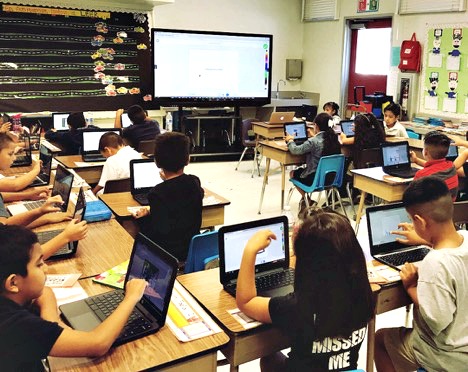With every academic school year, there comes the opportunity to champion new initiatives and implement new instructional practices that can better address the school’s needs. Big picture? New year equates new beginnings. Unfortunately, those new beginnings are not always easy to implement as more often than not, staff mindsets are difficult to shift, and comfort zones are difficult to abandon.
A few weeks ago, I had my own taste of resistance as I launched a new instructional plan to our staff that was meant to target the integration of digital learning into our intervention model. Since I know that any new way of doing something will always be met with some kind of criticism, I prepared myself to provide the logic to why a blended learning model could help support our struggling students, while providing our students already at grade level the opportunity to also be challenged. While in theory the model made sense — two stations, one focused on digital learning that was self-paced and individualized, the other station could vary according to teacher’s choice and the teacher would be released to pull students aside for small group intervention that targeted critical areas of need — I was met with more resistance than expected.
In reflecting about why there was so much negativity towards the proposed change, I realized that one of the biggest challenges with moving a school forward comes with how uncomfortable it is to leave what one is used to in order to enter a new space. Our school’s former intervention model did not require every day integration of technology. Unfortunately, the inconsistent use of technology from class to class created gaps in basic digital knowledge and skills amongst our students, a gap that was most noticeable when analyzing our statewide assessment data, derived from end-of-the-year online assessments. Still, in knowing the potential of our school and the talent our teachers possessed, I knew it was a battle worth taking on. Blended learning was not meant to change the way teachers taught intervention; it was meant to enhance learning and allow technology to serve as yet another layer of support in the classroom. As George Couros, the guru of technology integration in classroom often shares in his professional development sessions, “Technology will not replace great teachers, but technology in the hands of great teachers can be transformative.” With that mindset at the forefront of our new instructional model, I have already been able to witness magic happen in the classroom.
I don’t expect for the new blended learning model to completely transform our school’s culture of learning from one day to another. I know that this is a long journey along with many more roadblocks ahead. But the focus is on so much more than simply implementing a new model; the real goal is in helping shift mindsets. Often, teachers with years of experience in the classroom build their own style and become comfortable with their teaching practices. Although consistency can be beneficial, it can also cause complacency. Great teachers acknowledge that in order to best serve students, they must be willing to also continue being students themselves by learning new approaches and adding new tools to their teacher toolkit.
As we prepare our students to meet the needs of the 21st century, it is important for educators to be comfortable with challenging the status quo. Push each other to try new strategies in the classroom. Don’t be threatened by the increased need for technology integration; rather, use technology as a tool. Be innovative and think outside the box. Just because one way has worked fine over the years, that does not mean a new way can’t have better results. There is no need to reinvent the wheel, but there is a need to continue enhancing that wheel.
Alma Renteria
Latest posts by Alma Renteria (see all)
- Rincón Universitario: Cómo Escribir una Narrativa Auténtica para Solicitudes de Universidades, Parte 3 - October 17, 2019
- College Corner: How To Write An Authentic Narrative for College Applications, Part 3 - October 15, 2019
- Rincón Universitario: Cómo Escribir Una Narrativa Auténtica para Solicitudes Universitarias, Parte 2 - October 1, 2019
- College Corner: How To Write An Authentic Narrative for College Applications, Part 2 - September 26, 2019
- College Corner: Cómo Escribir un Relato Auténtico de Solicitudes para la Universidad, Parte 1 - September 4, 2019

